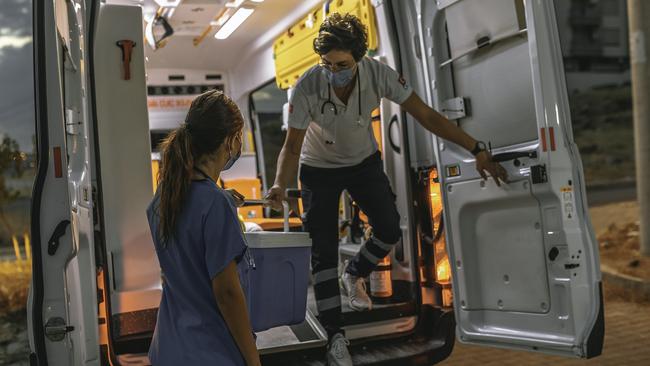The true story of a heart shared between two children
Heart-rending doesn’t begin to cover the scene of Joe Ball, standing outside the ambulance bay as his daughter’s heart speeds away from him forever.

THIS is the true story of a single heart that is shared between two nine-year-old children, a dying girl and a dying boy. Keira Ball was left brain dead after a car accident. Max Johnson had spent the best part of a year on a transplant list. His own heart — ruined by a virus — was bloated, flopping, giving up hope in his chest.
Both were ghost children in their own ways, hovering round our definitions of “alive”.
Max needed a heart. Keira was brain-damaged. The heart-distribution maths seems easy. Except, it’s so far from easy.
Heart-rending — there are almost too many heart metaphors made literal for this story — doesn’t begin to cover the scene of Joe Ball, Keira’s father, standing outside the ambulance bay as her heart speeds away from him for ever. He stands and watches as this bit of his daughter, stashed in an insulated cool box exactly like the model used for summer picnics, is loaded on to the vehicle.
Joe stays watching as it vanishes down the road: “I had to see it.”

The Story of a Heart is the fourth book by the palliative care doctor Rachel Clarke. It stitches together the story of Keira and Max’s heart with the biography of an organ, the jumping bean that was for most of the history of medicine deemed inoperable. So we also learn about the pioneering heart repair surgeons of the Second World War, whose chaotic operations involved grappling with hearts shooting great, drenching arcs of gore across the room, their hands rummaging blindly in bloody foam.
Clarke is best known for Dear Life, her 2020 bestseller about working in a hospice — dispatches from the dispatch ward. In 2021 she wrote Breathtaking, about working as a doctor during the Covid pandemic, which was made into a TV series. Clarke moonlights from the British National Health Service as a writer who dissects our cultural nerves, occupying a beloved place in the booming med-lit genre, along with writers like Henry Marsh and Adam Kay.
But this book is different. At its heart — excuse me again — is a challenge. This is not so much “would you donate your organs?” — the battle of public opinion has been won on this one. It is instead: “How much do you want to know?” Can we put aside our squeamishness about the “dead, but not quite” status of organ donors to face the facts about, as Clarke puts it, “ransacked chests”?
The med-lit genre opens up the secrets of medicine and Clarke could not have rendered this story more tenderly. By the time we get to the transplant in the final chapters, we have got to know the Ball and Johnson families intimately. Clarke does justice to the trust they placed in her. This is humane writing. Yet still, after all that, what happened to Keira in the hospital felt to me like a violation.
I support organ donation, yet the reality of what Clarke describes is also hard to know. When Keira, looking radiantly alive in her little pyjamas, her rosiness artificially supplied by life-support machines, is wheeled away to surgery, Clarke emphasises that she is treated as a “cherished little girl ... emphatically not a warehouse of spare parts”. Yet the phrase, “the retrieval team are ready” lands so painfully in the room where the Ball family are saying their last goodbyes.
Clarke writes beautifully of the moment that the brain supplanted the heart as the “cardinal sign of vivacity”, as momentous a scientific shift as dethroning the Earth from the centre of the universe. Joe doesn’t need to know all this: he is a human like the rest of us, being told that his daughter, his breathing daughter with a heart pumping in her chest, with a warm hand that has a reflex action that seems to clutch his, is dead. This “warm, pulsating lifelessness” is too much to compute.
Max’s heart is cut from his chest. “Throw it in the bin!” orders his surgeon. Meanwhile, 500km away across the country, Keira’s surgeon is poised with a headlamp, “like a miner readying himself to dig, to bring to the surface buried treasure”. Her body is drained of its blood, her heart raised in one of his hands while he severs its clinging tangle of veins. Her chest cavity — now eerily empty — is packed with wadding. The operating theatre looks like a war zone, but Keira is reclothed in a pink taffeta party dress with “an abundance of kindness”.
This book doesn’t have such an obviously wide appeal as Clarke’s previous works. We all aim for the good deaths; we all hope dearly that the agonies of the Ball and Johnson families do not befall us. Yet Clarke examines here not so much what it is to have a good death as what it is to have a hero’s death. The Ball family were guided by Keira’s generosity: she would give away “her last sweet”. The word “courage” finds its definition in Joe.
But while the Ball family helped the Johnson family — Max is now a towering teenager — the Johnson family also helped the Balls.
They gave Keira’s death meaning, and the chance for Joe to visit Max. Joe put a stethoscope next to Max’s chest.
The ba-boom ba-boom of his daughter’s heart sent him a Morse code of love.






To join the conversation, please log in. Don't have an account? Register
Join the conversation, you are commenting as Logout